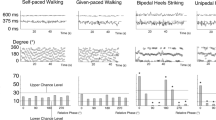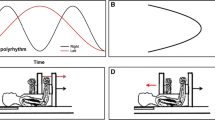Summary
Rhythmic flexion-extensions of ipsilateral hand and foot are easily performed (“easy” association) when the two segments are moved in phase (isodirectionally), whereas great care and attention are required (“difficult” association) to move them in phase opposition. We searched for features distinguishing the two types of coupling by analyzing, on ten subjects: 1) the frequency limit in each association; and, 2) if coupling is modified by inertial or elastic loading of the hand. 1) Subjects were asked to oscillate hand and foot at various paced frequencies, in the easy or in the difficult association for one minute at least. In the easy coupling, the task was performed up to 2.0–2.5 Hz, the duration being thereafter shortened by muscular fatigue. In the difficult coupling when the frequency was increased above 0.7–1.7 Hz, the performance rapidly shortened, not because of fatigue but because of an inevitable reversal to the in-phase movement. The frequency-duration curve always followed a similar decay, although it covered different frequency ranges in the various subjects. 2) The effect of charging the hand with inertial or elastic loads was studied at the subject's preferred frequency, chosen when the hand was unloaded. Without loading, in the easy association the hand cycle slightly lagged the foot cycle while in the difficult one an almost perfect phase opposition was maintained. Under inertial load (inertial momentum: 9 gm2), in the easy association the hand lag was increased by 10° to 45°, despite a compensatory advanced activation of the forearm EMG; in the difficult association, instead, the hand lag was small (less than 10°), thanks to an even earlier onset of the forearm EMG. The elastic load (torque: 4 gm) had negligible effects on the phase relation between movements but improved the phase relation between EMGs. These findings show that coupling is tighter in the difficult than in the easy association, a feature that is emphasized by the effect of the load. This supports the idea that kinaesthetic afferences have more pronounced influences on control of the anti-phase than the in-phase coupling.
Similar content being viewed by others
References
Andersson O, Grillner S (1983) Peripheral control of the cat's step cycle. Acta Physiol Scand 118:229–239
Baldissera F, Cavallari P, Marini G, Tassone G (1988) Kinaesthesic control in rhythmic coupled movements of ipsilateral limbs. Europ J Neurosci Suppl 1:228
Baldissera F, Cavallari P, Civaschi P (1982) Preferential coupling between voluntary movements of ipsilateral limbs. Neurosci Lett 34:95–100
Conway BA, Hultborn H, Kiehn O (1987) Proprioceptive input resets central locomotor rhythm in the spinal cat. Exp Brain Res 68:643–656
Gautier GM, Vercher J-L, Mussa Ivaldi F, Marchetti E (1988) Oculo-manual tracking of visual targets: control learning, coordination control and coordination model. Exp Brain Res 73:127–137
Gautier GM, Mussa Ivaldi F (1988) Oculo-manual tracking of visual targets in monkey: role of the arm afferent information in the control of arm and eye movements. Exp Brain Res 73:138–154
Iscoe S, Polosa C (1976) Synchronization of respiratory frequency by somatic afferent stimulation. J Appl Physiol 40:138–148
Kawahara K, Kumagai S, Nakazono Y, Miyamoto Y (1988) Analysis of entrainement of respiratory rhythm by somatic afferent stimulation in cats using phase response curves. Biol Cybern 58:235–242
Kelso JAS (1984) Phase transitions and critical behavior in human bimanual coordination. Am J Physiol Reg Integ Comp 15:R1000-R1004
Klapp ST, Hill MD, Jagacinski RJ, Jones MR, Tyler JG, Martin ZE (1985) On marching to two different drummers: perceptual aspects of the difficulties. J Exp Psych Hum Perc Perf 11:814–827
Meige H (1901) Les mouvements en miroir: leurs applications prâtiques et thérapeutiques. Rev Neurol 19:780
Viala D, Vidai C (1978) Evidence for distinct spinal locomotion generators supplying respectively fore- and hindlimbs in the rabbit. Brain Res 155:182–186
Viala D (1986) Evidence for direct reciprocal interactions between the central rhythm generators for spinal “respiratory” and locomotor activities in the rabbit. Exp Brain Res 63:225–232
Author information
Authors and Affiliations
Rights and permissions
About this article
Cite this article
Baldissera, F., Cavallari, P., Marini, G. et al. Differential control of in-phase and anti-phase coupling of rhythmic movements of ipsilateral hand and foot. Exp Brain Res 83, 375–380 (1991). https://doi.org/10.1007/BF00231161
Received:
Accepted:
Issue Date:
DOI: https://doi.org/10.1007/BF00231161




